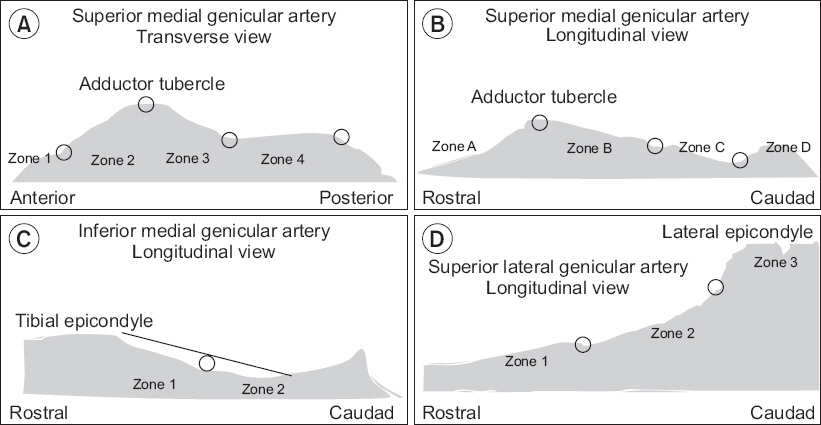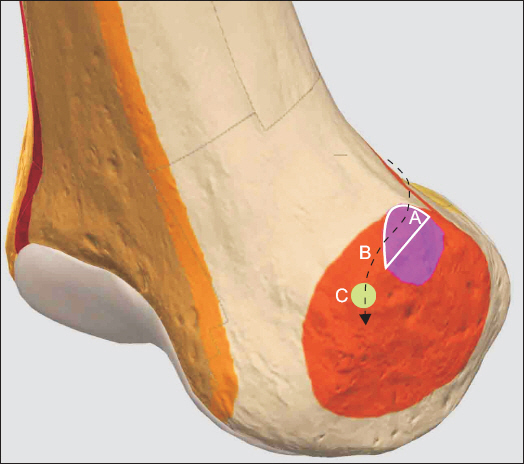Anesth Pain Med.
2019 Jan;14(1):67-75. 10.17085/apm.2019.14.1.67.
Localization of the genicular arteries under ultrasound guidance
- Affiliations
-
- 1Department of Anesthesiology and Pain Meidcine, Hanyang University Seoul Hospital, Seoul, Korea. jcshim@hanyang.ac.kr
- KMID: 2434202
- DOI: http://doi.org/10.17085/apm.2019.14.1.67
Abstract
- BACKGROUND
The genicular arteries (GAs) can be utilized for genicular nerve block. We aimed to evaluate the ability to localize GAs under ultrasound in patients with chronic knee pain.
METHODS
Twenty-four knees from 14 osteoarthritic patients were enrolled. The target GAs included the superomedial GA (SMGA), superolateral GA (SLGA), and inferomedial GA (IMGA). GAs were observed at the relevant adductor tubercle and epicondyle-shaft transition under ultrasound. Distribution of the SMGA at the adductor tubercle was evaluated using defined zones in transverse and longitudinal ultrasound images. SLGA and IMGA were also categorized using defined zones in longitudinal images. Distance from bony cortex to the relevant GA was then estimated.
RESULTS
Among 24 knees, 91.7% of SMGAs were located at the upper part of the adductor tubercle. The distances between the SMGA and bony cortex on transverse view (dSMGAt) and on longitudinal view (dSMGAl) were directly correlated (rs = 0.6539, P = 0.0005).
CONCLUSIONS
Under ultrasound guidance, the SMGA was found to be mainly localized to the upper part of the adductor tubercle. Likewise, the SLGA and IMGA were mainly localized at the distal and proximal parts of the epicondyle-shaft transition, respectively. Our results support the feasibility of ultrasound guidance for GA localization in patients with knee osteoarthritis.
Keyword
Figure
Reference
-
1. Horner G, Dellon AL. Innervation of the human knee joint and implications for surgery. Clin Orthop Relat Res. 1994; 301:221–6.2. Choi WJ, Hwang SJ, Song JG, Leem JG, Kang YU, Park PH, et al. Radiofrequency treatment relieves chronic knee osteoarthritis pain: a double-blind randomized controlled trial. Pain. 2011; 152:481–7. DOI: 10.1016/j.pain.2010.09.029. PMID: 21055873.3. Ikeuchi M, Ushida T, Izumi M, Tani T. Percutaneous radiofrequency treatment for refractory anteromedial pain of osteoarthritic knees. Pain Med. 2011; 12:546–51. DOI: 10.1111/j.1526-4637.2011.01086.x. PMID: 21463469.4. Bellini M, Barbieri M. Cooled radiofrequency system relieves chronic knee osteoarthritis pain: the first case-series. Anaesthesiol Intensive Ther. 2015; 47:30–3. DOI: 10.5603/AIT.2015.0003. PMID: 25751290.5. Shen WS, Xu XQ, Zhai NN, Zhou ZS, Shao J, Yu YH. Radiofrequency thermocoagulation in relieving refractory pain of knee osteoarthritis. Am J Ther. 2017; 24:e693–700. DOI: 10.1097/MJT.0000000000000393. PMID: 26938761.6. Protzman NM, Gyi J, Malhotra AD, Kooch JE. Examining the feasibility of radiofrequency treatment for chronic knee pain after total knee arthroplasty. PM R. 2014; 6:373–6. DOI: 10.1016/j.pmrj.2013.10.003. PMID: 24373908.7. Meng M, Waldman RA, Waldman CW, Waldman SD. Ultrasound guided genicular nerve block-a motor sparing technique for the treatment of acute and chronic knee pain. Int J Anesthesiol Res. 2015; 3:37–43.8. Kesikburun S, Yaşar E, Uran A, Adigüzel E, Yilmaz B. Ultrasound-guided genicular nerve pulsed radiofrequency treatment for painful knee osteoarthritis: a preliminary report. Pain Physician. 2016; 19:E751–9. PMID: 27389118.9. Yasar E, Kesikburun S, Kılıç C, Güzelküçük Ü, Yazar F, Tan AK. Accuracy of ultrasound-guided genicular nerve block: a cadaveric study. Pain Physician. 2015; 18:E899–904. PMID: 26431143.10. Kalsi PS, Carrington RJ, Skinner JS. Therapeutic embolization for the treatment of recurrent hemarthrosis after total knee arthroplasty due to an arteriovenous fistula. J Arthroplasty. 2007; 22:1223–5. DOI: 10.1016/j.arth.2006.11.012. PMID: 18078896.11. Kayler DE, Lyttle D. Surgical interruption of patellar blood supply by total knee arthroplasty. Clin Orthop Relat Res 1988. 229:221–7. PMID: 3349681 .12. Kirschner S, Konrad T, Weil EJ, Bühler M. [False aneurysm of the lateral superior genicular artery. A complication after the implantation of a knee prosthesis]. Orthopade. 2004; 33:841–5. German. DOI: 10.1007/s00132-004-0638-z. PMID: 15095036.13. Lazaro LE, Cross MB, Lorich DG. Vascular anatomy of the patella: implications for total knee arthroplasty surgical approaches. Knee. 2014; 21:655–60. DOI: 10.1016/j.knee.2014.03.005. PMID: 24767718.14. Sung-Yoon W, Lee YI, Hun-Mu Y. Anatomy of superior medial genicular artery: a short cadaveric report. Clin Anat. 2016; 29:798–9. DOI: 10.1002/ca.22707. PMID: 26940044.15. Franco CD, Buvanendran A, Petersohn JD, Menzies RD, Menzies LP. Innervation of the anterior capsule of the human knee: implications for radiofrequency ablation. Reg Anesth Pain Med. 2015; 40:363–8. DOI: 10.1097/AAP.0000000000000269. PMID: 26066383.16. Shahid S, Saghir N, Cawley O, Saujani S. A cadaveric study of the branching pattern and diameter of the genicular arteries: a focus on the middle genicular artery. J Knee Surg. 2015; 28:417–24. DOI: 10.1055/s-0035-1549021. PMID: 25892007.17. Huang D, Wang HW, Xu DC, Wang HG, Wu WZ, Zhang HR. An anatomic and clinical study of the adductor magnus tendon-descending genicular artery bone flap. Clin Anat. 2011; 24:77–83. DOI: 10.1002/ca.21060. PMID: 20890971.18. Scheibel MT, Schmidt W, Thomas M, von Salis-Soglio G. A detailed anatomical description of the subvastus region and its clinical relevance for the subvastus approach in total knee arthroplasty. Surg Radiol Anat. 2002; 24:6–12. DOI: 10.1007/s00276-002-0004-y. PMID: 12197013.19. Sabalbal M, Johnson M, McAlister V. Absence of the genicular arterial anastomosis as generally depicted in textbooks. Ann R Coll Surg Engl. 2013; 95:405–9. DOI: 10.1308/003588413X13629960046831. PMID: 24025288. PMCID: PMC4188287.
- Full Text Links
- Actions
-
Cited
- CITED
-
- Close
- Share
- Similar articles
-
- Comparison of the efficacy of genicular nerve phenol neurolysis and radiofrequency ablation for pain management in patients with knee osteoarthritis
- Pseudoaneurysm of the Medial Superior Genicular Artery after Arthroscopic Partial Meniscectomy
- Comparison of ultrasound guided pulsed radiofrequency of genicular nerve with local anesthetic and steroid block for management of osteoarthritis knee pain
- Usefulness of Ultrasound-guided Mammotome Biopsy for Microcalcification
- Investigation of the existence of and a block technique for the inferior lateral genicular nerve: cadaveric study









